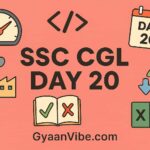GyaanVibe is a focused educational platform dedicated to helping SSC CGL aspirants crack Tier 1 & Tier 2 exam with a strategic, day-wise, and well-structured preparation approach.
SSC CGL Preparation – Day 20
Passage: The Digital Divide
The rapid growth of technology has brought remarkable changes to the modern world. From smart homes to AI-powered personal assistants, our lives are increasingly influenced by the digital realm. However, this advancement has also revealed a stark digital divide — a gap between those who have access to digital tools and the internet, and those who do not.
In urban areas, high-speed internet and smartphones have become almost ubiquitous, making services like online education, banking, and healthcare easily accessible. In contrast, many rural and remote regions still struggle with unreliable internet connections and lack of digital literacy. This disparity is not merely about having access to a device but about the ability to effectively use technology.
The digital divide has deep implications for equality. In education, students with access to online resources are at a clear advantage over their peers in underprivileged areas. Similarly, in the job market, employers increasingly seek candidates with digital proficiency. Without intervention, the gap is likely to widen, exacerbating existing socio-economic inequalities.
Governments and non-profit organizations have initiated programs to bridge this gap, but success remains limited due to infrastructural challenges and lack of awareness. Addressing the digital divide requires a multifaceted approach — improving infrastructure, investing in digital education, and creating policies that prioritize equitable access.
📘 Questions
1. What is the central theme of the passage?
A) The evolution of smartphones
B) Online banking systems
C) The impact of digital illiteracy
D) The digital divide and its consequences
✅ Answer: D) The digital divide and its consequences
🧠 Explanation: The passage primarily discusses the gap in digital access and its implications.
2. According to the passage, digital access is not just about having a device but also about:
A) Knowing how to repair it
B) Using it effectively
C) Using it to play games
D) Being able to sell it
✅ Answer: B) Using it effectively
🧠 Explanation: The author emphasizes the importance of digital literacy, not just access.
3. Which of the following is NOT mentioned as a consequence of the digital divide?
A) Educational inequality
B) Limited job opportunities
C) Political instability
D) Unequal healthcare access
✅ Answer: C) Political instability
🧠 Explanation: All other options are referenced, but political instability is not.
4. What is the tone of the author towards the digital divide?
A) Sarcastic
B) Indifferent
C) Concerned
D) Humorous
✅ Answer: C) Concerned
🧠 Explanation: The author stresses serious implications and suggests solutions → concerned tone.
5. The phrase “the gap is likely to widen” implies:
A) Digital access is becoming universal
B) Rural areas are catching up
C) Inequality in access may increase
D) Technology will stop progressing
✅ Answer: C) Inequality in access may increase
🧠 Explanation: It means the digital divide will become larger if unaddressed.
6. The author’s purpose is to:
A) Entertain the readers
B) Criticize technology
C) Inform and suggest solutions
D) Promote a brand
✅ Answer: C) Inform and suggest solutions
🧠 Explanation: The passage highlights the issue and suggests how to resolve it → informative + suggestive.
7. In the context, the word “ubiquitous” means:
A) Dangerous
B) Rare
C) Found everywhere
D) Confusing
✅ Answer: C) Found everywhere
🧠 Explanation: “Ubiquitous” = present everywhere → refers to smartphones/internet in urban areas.
8. What does the author suggest about existing government programs?
A) They are highly successful
B) They have resolved the problem
C) They are ineffective due to multiple barriers
D) They are unnecessary
✅ Answer: C) They are ineffective due to multiple barriers
🧠 Explanation: The author says programs exist but face infrastructural and awareness issues.
9. Which of the following best summarizes the final paragraph?
A) Bridging the digital divide is impossible
B) A single solution can close the gap
C) Only governments can solve the problem
D) Multiple efforts are needed to address the divide
✅ Answer: D) Multiple efforts are needed to address the divide
🧠 Explanation: The paragraph advocates for a multifaceted approach.
10. Which of the following statements is true according to the passage?
A) All urban people are digitally literate
B) Rural people don’t need digital access
C) Digital inequality impacts education and jobs
D) Technology has only widened inequality
✅ Answer: C) Digital inequality impacts education and jobs
🧠 Explanation: Clearly stated in the middle of the passage.




